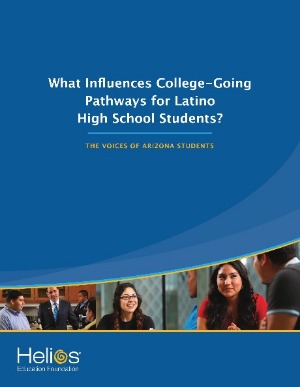What Influences College-Going Pathways for Latino High School Students
Overview
This policy brief, entitled What Influences College-Going Pathways for Latino High School Students?: The Voices of Arizona Students, summarizes Arizona Latino high school students’ perspectives on factors that have influenced their college aspirations and future plans to attend a postsecondary institution. This brief provides the unique opportunity to hear directly from students — in their own words — about the factors that support or impede their entry into college.
In 2015, these questions, together with our desire to improve education through research, led us to commission a two-part, mixed-methods study aimed at identifying policy levers to improve postsecondary attainment. In collaboration with Dr. Paul G. Perrault, Vice President and Director of Research and Evaluation at Helios, Dr. Nancy Gonzales and Dr. Leah Doane at Arizona State University led the qualitative portion of the study, aimed at assessing Latino perceptions of higher education. Over the course of a year, they carried out focus groups with Latino students from five Arizona high schools. Their work is meant to describe Latino perceptions of higher education and college-going at a deeper level.
This brief summarizes findings from Part 1 of our mixed-methods research. Specifically, this brief summarizes what we learned from focus group discussions conducted with students from five Arizona high schools relative to the following three questions:
- What are the most common and impactful sources of influence to support college-going pathways for Latino high school students in Arizona?
- Are there formal or informal influences that are shared across schools and students at different aspiration levels?
- How can this information be used to broaden college-going pathways and success for more students?
Perhaps not surprisingly, the role of the family was emphasized as the most important influence on college aspirations. Individual family members, prior and current family experiences, and family practices influenced students in multiple ways. In addition, the school environment was emphasized as a source of support and information for students as they pursue a postsecondary education. And finally, the brief identifies seven recommendations based on the students’ feedback to help boost college-going rates and success among future Latino students.
As we think about the future of Arizona, we must acknowledge the changing demographics of our state and embrace the fact that Latino students make up the largest percentage of our state’s K-12 education system. Increasing the number of Latino students who pursue and complete a postsecondary degree is critical to ensuring the future economic stability of our state.


